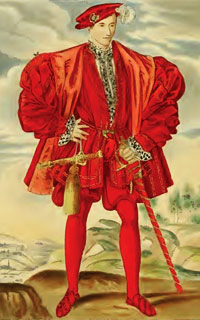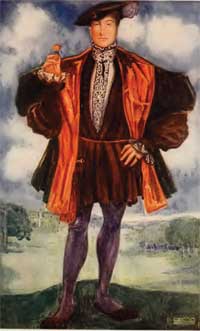Men’s Renaissance costume under Henry VIII
The typical men’s Renaissance clothing included the distinct shirt, cut low in the neck, and sewn with black embroidery. The shirt of the previous reign was cut even lower, with a creased hem drawn together with laces. Now the cut was altered and made so that the hem frilled out round the neck, like a collar. People with a thick neck, like Henry himself, wore the collar of the shirt turned down and tied with strings of linen. The cuffs of the shirt, when they showed at the wrist, were sewn with elaborate designs in black thread or silk.
The little waistcoat ended at the waist and was cut straight across from shoulder to shoulder. It was tied with thongs of leather or coloured laces to the breeches. Above these, a gap was showing the shirt. The pouch on the breeches was highly decorated and jeweled. The sleeves and the breeches were cut, puffed, and slashed all over, so that the shirt might be pushed through the holes.

Earl of Surrey
The caps were either little flat caps with the rim cut at intervals, or large flat hats similar to those of the reign of Henry VII, covered with feathers and slashed. The men wore hanging hair, or short hair which came into fashion about 1521. Cloaks and overcoats similar to a dressing-gown were worn over the dress.
Men's Renaissance clothing included pairs of sleeves worn with the waistcoats, a favorite sleeve trimming being the broad velvet bands. This waistcoat was generally made of a richly ornamented material, slashed and puffed or plain. Its effect relied on the richness of the embroidery or the design of the fabric. The waistcoat generally had sleeves, and in most cases the sleeves were detachable, so it could be worn without them if preferred.
The coat was made with bases like a frock, a skirted coat. Generally, it was made of plain velvet, fine cloth, silk, or satin. It could be open to the waist, open all the way in front, or close to the neck. When the coat was open in front it was showing the jeweled pouch. The coat was held at the waist with a sash of silk tied in a bow with short ends.
Depending on their particular taste, the gentlemen could wear sleeves to their coats, or simply showing the sleeves of their waistcoats. Towards the end of Henry’s reign, the coat with sleeves and the high neck became popular. Men almost renounced to wear the waistcoat, and the collar grew, spread in ruffle and folded pleat round the neck.
The men’s Renaissance overcoat was worn according to taste. The fashion conscious wore the overcoat cut shorter, reaching not far below the knee. The conservatives preferred the long one. Both categories wore the wide collar stretching well over the shoulders. The collar was made of fur, satin, silk, or of cloth of gold, while the folds of the overcoats gave a sense of splendor and dignity.
The fashionable Renaissance overcoats had their short sleeves puffed and swollen, reaching only to the elbow, and ending in a hem of fur or some rich stuff.

A Gentleman of the Time of Henry VIII
Beneath these garments men wore the trunks, which were loose little breeches. Following the German style, they were bagged, puffed, rolled, or slashed. The cutting of slashes was not straight, but curved like an elongated S or a double S. Other slashes were squared top and bottom. Men wore tight hose, sometimes puffed at the knee. The bagging, sagging, and slashing of hose underlined the separate breeches or trunks.
The portrait of the Earl of Surrey by William Scrots is a fine example of the Renaissance costume for men. The Earl is dressed entirely in scarlet, and wears a short doublet, open in front to display the fine white shirt, ornamented with black embroidery, same as the ruffles. It is fastened round the waist by a girdle, to which is attached a dagger in a richly gilt case. The doublet is very broad at the shoulders, and very wide in the sleeves, which are gathered, and puffed and slashed according to the fashion.
The type of small flat cap shown will eventually replace the broad hat and its huge circle of feathers, worn during the early part of the reign. The shoes are also scarlet, and probably of velvet, crossed by bands of a darker tint, and enriched with jewels.
The best term to describe the men’s Renaissance clothing under Henry VIII would be “broad”: the costume was broad at the shoulders, and even the shoes were very broad at the toes, often quite square, sewn with precious stones, and puffed with silk.
Women’s Renaissance clothing in the times of Henry VIII.
Men’s and women's clothing during the reigns of Edward and Mary.
Elizabethan costume.
Renaissance clothing page.